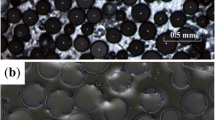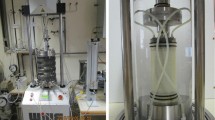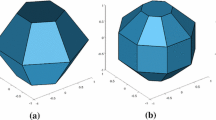Abstract
Sintering of tiny spherical glass beads induced by oscillating diametric compression at room temperature is considered. The amorphous glass beads are modeled as isotropic elasto-plastic solid with bilinear stress-strain constitutive relationship, which is implemented in a finite element code. The coupled thermal and mechanical response of the glass beads under cyclic compressions is investigated. Our numerical simulations show that the local temperatures and stresses near the contact points can significantly be raised during adiabatic compression cycles. The temperature rise is more pronounced for contact between two beads with different sizes or for contact with more neighboring beads. There exist temperature and stress gradients from the interiors toward the contact points. These findings provide a feasible explanation for the sintering found in recent triaxial compression experiments with tiny glass beads under room temperature and low pressure.
















Similar content being viewed by others
Notes
A similar phenomenon is reported in e.g. [12], in which colliding of two large steel balls with a thin sheet of material in between may “burn” or “melt” a hole on the sheet.
Glass is in fact a rheological fluid in supercooled region.
Single monotonic diametric compression is equally applicable with maximum compression displacement to trigger viscous flows of materials, leading to fracture of glass beads.
Spherical grains are assumed to distort into oblate spheroids with \(c=d>b\).
The density and thermal conductivity are quoted from [3, 4], while the others are from [1, 2, 25] for conventional silica glasses. Since material properties depend significantly on sample size, e.g. [26–28], tiny glass beads may assume larger values in their properties, e.g. they are stronger in compression than their counterparts with normal size. Thus, numerical simulations with Table 1 deliver a conservative estimation on the stress and temperature fields.
This is done to simplify the analysis, for the focus of the study is to examine if the temperature and stress near the contact points can be risen sufficiently to trigger sintering. More accurate estimations can be accomplished when empirical temperature-dependent formulations of glass properties are taken into account.
In the compression, the dissipated energy in a single glass bead alters its temperature distribution. The temperature gradients on the bead boundary give rise to the convective heat transfer toward the interstitial air, and the conductive heat transfer among the neighboring beads in contact. These are lumped by prescribing the value of \(\mathbf {q}_s\). For the adiabatic case, all dissipated energy is confined within the bead, while half of the dissipated energy is taken into account in the thermo-mechanical response for the 50 % diathermal case.
The “two-calabash” conjunction is numerically possible, and yet recognized in experiments.
References
Ashby, A.F.: Materials and the Environment, 2nd edn. Butterworth-Heinemann, New York (2012)
Jones, D.R.H., Ashby, A.F.: Engineering Material I: An Introduction to Properties, Application and Design, 4th edn. Butterworth-Heinemann, New York (2011)
Hoang, M.T.: Frottement saccadé dans les maté riaux granulaires modèles. PhD Thesis, L’Institut National des Sciences Appliquées de Lyon, France (2011)
Doanh, T., Hoang, M.T., Roux, J.-N., Dequeker, C.: Stick-slip behavior of model granular materials in drained triaxial compression. Granul. Matter 15(1), 1–23 (2013)
Rahaman, M.N.: Ceramic Processing. Taylor & Francis, New York (2007)
Kirchhof, M.J., Schmid, H.-J., Peukert, W.: Three-dimensional simulation of viscous-flow agglomerate sintering. Phys. Rev. E 80, 026319 (2009)
Prado, M.O., Zanotto, E.D., Fredericci, C.: Sintering polydispersed spherical glass particles. J. Mater. Res. 18(6), 1347–1354 (2003)
Prado, M.O., Nascimento, M.L.F., Zanotto, E.D.: On the sinterability of crystallizing glass powders. J. Non-Cryst. Sol. 354, 4589–4597 (2008)
Ristić, M.M., Milosević, S.Dj: Frenkels theory of sintering. Sci. Sinter. 38, 7–11 (2006)
Skorokhod, V.V.: Development of the ideas of Ya. I. Frenkel’ in the contemporary rheological theory of sintering. Powder Metall. Metal Ceram. 34(9), 521–527 (1995)
Yadha, V., Helble, J.J.: Modeling the coalescence of heterogeneous amorphous particles. Aero. Sci. 35, 665–681 (2004)
Hessel, R., Perinotto, A.C., Alfaro, R.A.M., Freschi, A.A.: Force-versus-time curves during collisions between two identical steel balls. Am. J. Phys. 74(3), 176 (2006)
Geng, J., Howell, D., Longhi, E., Behringer, R.P., Reydellet, G., Vanel, L., Clément, E., Luding, S.: Footprints in sand: the response of a granular material to local perturbations. Phys. Rev. Lett. 87, 035506 (2001)
Dantu, P.: Etude Statistique des Forces Intergranulaires dans un Milieu Pulvérulent. Géotechnique 18(1), 50–55 (1968)
Howell, D., Behringeret, R.P., Veje, C.: Stress fluctuations in a 2D granular couette experiment: a continous transition. Phys. Rev. Lett. 82, 5241 (1999)
Wang, X.Y., Tang, N., Zheng, Z.Z., Tang, Y.Y., Li, J.J., Liu, L.: A Maxwell-pulse constitutive model of \(\text{ Zr }_{55}\text{ Cu }_{30}\text{ Al }_{10}\text{ Ni }_5\) bulk metallic glasses in supercooled liquid region. J. Alloys Compond. 509, 2518–2522 (2011)
Jun, H.-J., Lee, K.S., Kato, H., Kim, H.S., Chang, Y.W.: Constitutive model for high temperature deformation behavior of Ti-Zr-Ni-Be bulk metallic glass in supercooled liquid region. Comput. Mater. Sci. 61, 213–223 (2012)
Anand, L., Su, C.: A constitutive theory for metallic glasses at high homologous temperaturs. Acta Mater. 55, 3735–3747 (2007)
Chakrabarty, J.: Theory of Plasticity, 3rd edn. Butterworth-Heinemann, Oxfor (2006)
Frenkel, J.: Viscous flow of crystalline bodies under the action of surface tension. J. Phys. USSR 9, 385–391 (1945)
Batchelor, G.K.: An Introduction to Fluid Mechanic. Cambridge University Press, New York (1992)
Marsh, D.M.: Plastic flow in glass. Proc. Roy. Soc. A 279, 420–435 (1964)
Chen, Y.T., Chen, C.M.: Can stress-strain relationships be obtained from indentation curves using conical and pyramidal indenters? J. Mater. Res. 14(9), 3493–3496 (1999)
Lockner, D., Okubo, P.: Measurements of friction heating in granite. J. Geophys. Res. 88, 4313–4320 (1983)
Mysen, B.O., Ricjter, P.: Silicate Glasses and Melts: Properties and Structures. Elsevier, Amsterdam (2005)
Koike, A., Tomozawa, M.: IR investigation of density changes of silica glass and soda-lime silicate glass caused by microhardness identation. J. Non-Cryst. Solids 353, 2318–2327 (2007)
Zhao, Y., Gong, B., Deng, C.: A fractal interpretation of size effects on the strength of metallic glasses. Ohys. Lett. A 366, 2877–2879 (2013)
Chen, Y.T., Wu, C.W.: Effect of grain size on nano-identation property of \(\text{ Co }_{60}\text{ Fe }_{20}\text{ B }_{20}\) thin flim. J. Alloy. Compond. 551, 360–364 (2013)
Mauro, J., Yue, Y., Ellison, A.J., Gupta, P.K., Allan, D.C.: Viscosity of glass-forming liquids. PNAS 24, 19780–19784 (2009)
Flügel, A.: Glass viscosity calculation based on a global statistical modeling approach. Eur. J. Glass Sci. Technol. A 48, 13–30 (2007)
Kamarkar, S., Dasgupta, C., Sastry, S.: Growing length and time scales in glass-forming liquids. Proc. Nat. Acad. Sci. USA 106, 3675–3679 (2009)
Bansal, N.P., Doremus, R.H.: Handbook of Glass Properties. Academic press, London (1986)
Sadd, M.H.: Elasticity: Theory, Applications, and Numerics, 3rd edn. Elsevier, New York (2014)
Zheng, B., Elsworth, D.: Strength evolution in heterogeneous granular aggregates during chemomechanical compaction. Int. J. Rock Mech. Mining Sci. 60, 217–226 (2013)
Scuderi, M.M., Carpenter, B.M., Marone, C.: Physicochemical processes of frictional healing: effects of water on stick-slip stress drop and friction of granular fault gouge. J. Geophys. Res. Solid Earth 119, 1–14 (2014)
Acknowledgments
The authors are indebted to the Ministry of Science and Technology, Taiwan, for the financial support via the project NSC 102–2221–E–006–198. The authors also thank the editor and reviewers for their comments and suggestions which led to improvements.
Author information
Authors and Affiliations
Corresponding author
Ethics declarations
Conflict of interest
The study was supported by the Ministry of Science and Technology, Taiwan, via the project NSC 102–2221–E–006–198. The results have not been presented elsewhere. All authors agree to the content of the paper, and authorize the corresponding author to be representative for all copyright and submission issues. The authors also declare that no competing interests exist.
Rights and permissions
About this article
Cite this article
Fang, C., Wu, W., Lin, YJ. et al. On sintering of tiny glass beads in oscillating diametric compressions. Granular Matter 18, 73 (2016). https://doi.org/10.1007/s10035-016-0669-2
Received:
Published:
DOI: https://doi.org/10.1007/s10035-016-0669-2




